Effect of Lateral Confining Pressure on Shale’s Mechanical Properties and Its Implications for Fracture Conductivity
Abstract
:1. Introduction
2. Materials and Methods
2.1. Samples and Sample Preparation
2.2. Unconfined Compression Testing
2.3. Microindentation Testing
3. Results
3.1. Indentation Load–Displacement Curves
3.2. Young’s Modulus and Brinell Hardness
3.3. Fracture Toughness
4. Discussion
4.1. Enhancement Mechanisms of Shale’s Mechanical Characteristics under Confining Pressure
- (1)
- Compression of micropores and fractures: The application of confining pressure on shale leads to the compression of micropores and fractures, resulting in a reduction in their size and volume. This compression effect increases the density of the rock and decreases the number and size of micropores, thereby enhancing the shale’s strength and stiffness [39,40]. Therefore, this compression improves the fracture toughness of the shale while reducing its deformability.
- (2)
- Uniform stress distribution: The application of confining pressure in shale samples ensures a more homogeneous distribution of applied stress [41]. Without confining pressure, external loading can result in stress concentration. However, by applying confining pressure, the stress is more evenly distributed across the sample, reducing stress concentration and enhancing overall strength.
- (3)
- Particle contact: Through the application of confining pressure, the particles within the shale come into closer contact and undergo compaction [42]. This densification process leads to increased interparticle interaction, resulting in the enhanced strength and hardness of the shale. Furthermore, the denser particle arrangement reduces microscale particle displacement, effectively reducing the deformability of the shale. The promotion of particle contact under confining pressure contributes to improved mechanical properties and reduced deformation in the shale.
4.2. Effect of Lateral Confining Pressure on Proppant Embedment
4.3. Effect of Lateral Confining Pressure on Fracture Conductivity
5. Conclusions
- The load–displacement curves obtained from the microindentation tests under various confining pressures demonstrate a decreasing trend in ultimate displacements with higher levels of confining stress. This observation indicates that the depth of the proppant embedment decreases when taking reservoir confining pressure into consideration;
- Young’s moduli, Brinell hardness, and fracture toughness exhibit a direct linear correlation with increasing confining pressure, suggesting that applying confining pressure enhances the strength and hardness of the shale;
- Considering the effects of confining pressure, the decrease in proppant embedment is proportional to Young’s modulus of the shale. Regarding fracture conductivity, for larger-sized proppants (e.g., D = 2.50 mm), the influence of confining pressure on fracture conductivity is relatively minor. However, when using smaller-sized proppants (e.g., D = 1.00 mm), especially in scenarios where prolonged shale–hydraulic fracturing fluid interaction results in significant shale debris swelling, there is a noticeable improvement in fracture conductivity when confining pressure is taken into account. Overall, previous computational models have tended to overestimate the depth of proppant embedment while underestimating the assessment of fracture conductivity.
Author Contributions
Funding
Institutional Review Board Statement
Informed Consent Statement
Data Availability Statement
Conflicts of Interest
References
- Wang, G.; Liu, G.; Zhao, Z.; Liu, Y.; Pu, H. A Robust Numerical Method for Modeling Multiple Wells in City-Scale Geothermal Field Based on Simplified One-Dimensional Well Model. Renew. Energy 2019, 139, 873–894. [Google Scholar] [CrossRef]
- Chen, L.; Jiang, Z.; Liu, K.; Wang, P.; Ji, W.; Gao, F.; Li, P.; Hu, T.; Zhang, B.; Huang, H. Effect of Lithofacies on Gas Storage Capacity of Marine and Continental Shales in the Sichuan Basin, China. J. Nat. Gas Sci. Eng. 2016, 36, 773–785. [Google Scholar] [CrossRef]
- Luo, S.; Wu, Y.; Li, Y.; Wang, D.; Kim, D.; Song, J.; Zhang, G. Nanoindentation-Enhanced Screening of Hydraulic Fracturing Fluid Additives. Int. J. Coal Geol. 2021, 240, 103744. [Google Scholar] [CrossRef]
- Du, J.; Hu, L.; Meegoda, J.N.; Zhang, G. Shale Softening: Observations, Phenomenological Behavior, and Mechanisms. Appl. Clay Sci. 2018, 161, 290–300. [Google Scholar] [CrossRef]
- Masłowski, M.; Labus, M. Preliminary Studies on the Proppant Embedment in Baltic Basin Shale Rock. Rock Mech. Rock Eng. 2021, 54, 2233–2248. [Google Scholar] [CrossRef]
- Sun, H.; He, B.; Xu, H.; Zhou, F.; Zhang, M.; Li, H.; Yin, G.; Chen, S.; Xu, X.; Li, B. Experimental Investigation on the Fracture Conductivity Behavior of Quartz Sand and Ceramic Mixed Proppants. ACS Omega 2022, 7, 10243–10254. [Google Scholar] [CrossRef] [PubMed]
- Li, J.H.; Li, B.B.; Cheng, Q.Y.; Gao, Z. Characterization of the Fracture Compressibility and Its Permeability for Shale under the Effects of Proppant Embedment and Compaction: A Preliminary Study. Pet Sci. 2022, 19, 1125–1138. [Google Scholar] [CrossRef]
- Zheng, W.; Silva, S.C.; Tannant, D.D. Crushing Characteristics of Four Different Proppants and Implications for Fracture Conductivity. J. Nat. Gas Sci. Eng. 2018, 53, 125–138. [Google Scholar] [CrossRef]
- Zhang, J.; Ouyang, L.; Zhu, D.; Hill, A.D. Experimental and Numerical Studies of Reduced Fracture Conductivity Due to Proppant Embedment in the Shale Reservoir. J. Pet. Sci. Eng. 2015, 130, 37–45. [Google Scholar] [CrossRef]
- Sun, Z.; Zhang, H.; Wei, Z.; Wang, Y.; Wu, B.; Zhuo, S.; Zhao, Z.; Li, J.; Hao, L.; Yang, H. Effects of Slick Water Fracturing Fluid on Pore Structure and Adsorption Characteristics of Shale Reservoir Rocks. J. Nat. Gas Sci. Eng. 2018, 51, 27–36. [Google Scholar] [CrossRef]
- Yang, Z.; Wang, L.; Zhang, G.; Ho, C. SPE-181833-MS Micromechanical Characterization of Fluid-Shale Interactions via Nanoindentation. In Proceedings of the SPE Asia Pacific Hydraulic Fracturing Conference, Beijing, China, 24–26 August 2016. [Google Scholar]
- Yuan, W.; Pan, Z.; Li, X.; Yang, Y.; Zhao, C.; Connell, L.D.; Li, S.; He, J. Experimental Study and Modelling of Methane Adsorption and Diffusion in Shale. Fuel 2014, 117, 509–519. [Google Scholar] [CrossRef]
- Zhang, J.; Zhu, D.; Hill, A.D. Water-Induced Damage to Propped-Fracture Conductivity in Shale Formations. SPE Prod. Oper. 2016, 31, 147–156. [Google Scholar] [CrossRef]
- Liao, Z.; Deng, S.; Chen, X.; Wu, M.; Kang, Y.; Zeng, L.; Zou, H. Fracture Behavior of Longmaxi Shale with Implications for Subsurface Applications. Interpretation 2020, 8, 205–213. [Google Scholar] [CrossRef]
- Sanaei, A.; Shakiba, M.; Varavei, A.; Sepehrnoori, K. Mechanistic Modeling of Clay Swelling in Hydraulic-Fractures Network. SPE Res. Eval. Eng. 2018, 21, 96–108. [Google Scholar] [CrossRef]
- Wu, W.; Sharma, M.M. Acid Fracturing in Shales: Effect of Dilute Acid on Properties and Pore Structure of Shale. In Proceedings of the SPE Production and Operations; Society of Petroleum Engineers (SPE), The Woodlands, TX, USA, 1 February 2017; Volume 32, pp. 51–63. [Google Scholar]
- Kasyap, S.S.; Senetakis, K. Characterization of Two Types of Shale Rocks from Guizhou China through Micro-Indentation, Statistical and Machine-Learning Tools. J. Pet. Sci. Eng. 2022, 208, 109304. [Google Scholar] [CrossRef]
- Yang, X.M.; Zhang, X.P.; Xie, W.Q.; Liu, Q.S.; Yang, X.W. Estimation of Rock Mechanical Properties by Macro Indentation Test with a Conical Indenter. Bull. Eng. Geol. Environ. 2023, 82, 234. [Google Scholar] [CrossRef]
- Bouali, A.; Grairia, S.; Nettour, D.; Chérait, Y.; Arabi, N.; Montagne, A.; Iost, A.; Chicot, D. Instrumented Indentation Based Methods to Assess Fracture Toughness (KIC) of Self-Compacting Concrete: Influence of Water to Binder (w/b) Ratio and Type of Concrete. Eng. Fract. Mech. 2022, 275, 108796. [Google Scholar] [CrossRef]
- Fadil, H.; Jelagin, D.; Partl, M.N. Spherical Indentation Test for Quasi-Non-Destructive Characterisation of Asphalt Concrete. Mater. Struct./Mater. Constr. 2022, 55, 102. [Google Scholar] [CrossRef]
- Liu, Y.; Li, Y.; Jin, C.; Li, H. Multi-Scale Creep Analysis of Cement Paste—Indentation Prediction and Time Correspondence of Mechanisms. Cem. Concr. Compos. 2022, 134, 104815. [Google Scholar] [CrossRef]
- Vandamme, M.; Ulm, F.J. Nanoindentation Investigation of Creep Properties of Calcium Silicate Hydrates. Cem. Concr. Res. 2013, 52, 38–52. [Google Scholar] [CrossRef]
- Bobko, C.; Ulm, F.J. The Nano-Mechanical Morphology of Shale. Mech. Mater. 2008, 40, 318–337. [Google Scholar] [CrossRef]
- Sorelli, L.; Constantinides, G.; Ulm, F.J.; Toutlemonde, F. The Nano-Mechanical Signature of Ultra High Performance Concrete by Statistical Nanoindentation Techniques. Cem. Concr. Res. 2008, 38, 1447–1456. [Google Scholar] [CrossRef]
- Lu, Y.; Li, Y.; Wu, Y.; Luo, S.; Jin, Y.; Zhang, G. Characterization of Shale Softening by Large Volume-Based Nanoindentation. Rock Mech. Rock Eng. 2020, 53, 1393–1409. [Google Scholar] [CrossRef]
- Luo, S.; Lu, Y.; Wu, Y.; Song, J.; DeGroot, D.J.; Jin, Y.; Zhang, G. Cross-Scale Characterization of the Elasticity of Shales: Statistical Nanoindentation and Data Analytics. J. Mech. Phys. Solids 2020, 140, 103945. [Google Scholar] [CrossRef]
- Song, J.; Xiang, D.; Zhao, S.; Hu, D.; Zhou, H.; Zhang, G. Shale Softening Degree and Rate Induced by Fracturing Fluid under THMC Coupling Condition. J. Nat. Gas Sci. Eng. 2021, 96, 104294. [Google Scholar] [CrossRef]
- Song, J.; Xiang, D.; Hu, D.; Zhou, H.; Guo, D.; Zhang, G. Creep Characteristics of a Fracturing Fluid-Softened Shale Investigated by Microindentation. Int. J. Rock Mech. Min. Sci. 2022, 152, 105067. [Google Scholar] [CrossRef]
- Oliver, W.C.; Pharr, G.M. An Improved Technique for Determining Hardness and Elastic Modulus Using Load and Displacement Sensing Indentation Experiments. J. Mater. Res. 1992, 7, 1564–1583. [Google Scholar] [CrossRef]
- Oliver, W.C.; Pharr, G.M. Measurement of Hardness and Elastic Modulus by Instrumented Indentation: Advances in Understanding and Refinements to Methodology. J. Mater. Res. 2004, 19, 3–20. [Google Scholar] [CrossRef]
- Kitamura, M.; Hirose, T. Strength Determination of Rocks by Using Indentation Tests with a Spherical Indenter. J. Struct. Geol. 2017, 98, 1–11. [Google Scholar] [CrossRef]
- Zheng, W.; Tannant, D.D.; Cui, X.; Xu, C.; Hu, X. Improved Discrete Element Modeling for Proppant Embedment into Rock Surfaces. Acta Geotech. 2020, 15, 347–364. [Google Scholar] [CrossRef]
- Doerner, M.F.; Nix, W.D. A Method for Interpreting the Data from Depth-Sensing Indentation Instruments. J. Mater. Res. 1986, 1, 601–609. [Google Scholar] [CrossRef]
- Suo, Y.; Chen, Z.; Rahman, S.S.; Chen, X. Experimental Study on Mechanical and Anisotropic Properties of Shale and Estimation of Uniaxial Compressive Strength. Energy Sources Part A Recovery Util. Environ. Eff. 2020. [Google Scholar] [CrossRef]
- Gupta, I.; Sondergeld, C.; Rai, C. Fracture Toughness in Shales Using Nano-Indentation. J. Pet. Sci. Eng. 2020, 191, 107222. [Google Scholar] [CrossRef]
- Liu, Y. Fracture Toughness Assessment of Shales by Nanoindentation. Master’s Thesis, University Massachusetts, Amherst, MA, USA, 2015. [Google Scholar] [CrossRef]
- Liu, K.; Ostadhassan, M.; Bubach, B. Applications of Nano-Indentation Methods to Estimate Nanoscale Mechanical Properties of Shale Reservoir Rocks. J. Nat. Gas Sci. Eng. 2016, 35, 1310–1319. [Google Scholar] [CrossRef]
- Cheng, Y.T.; Li, Z.; Cheng, C.M. Scaling Relationships for Indentation Measurements. Philos. Mag. A Phys. Condens. Matter Struct. Defects Mech. Prop. 2002, 82, 1821–1829. [Google Scholar] [CrossRef]
- Ma, C.; Zhu, C.; Zhou, J.; Ren, J.; Yu, Q. Dynamic Response and Failure Characteristics of Combined Rocks under Confining Pressure. Sci. Rep. 2022, 12, 12187. [Google Scholar] [CrossRef] [PubMed]
- Chen, X.; Tang, C.; Yu, J.; Zhou, J.; Cai, Y. Experimental Investigation on Deformation Characteristics and Permeability Evolution of Rock under Confining Pressure Unloading Conditions. J. Cent. South Univ. 2018, 25, 1987–2001. [Google Scholar] [CrossRef]
- Ma, W.; Luo, L.; Wang, J. Mechanical, Cracking and Failure Behavior of Oil Shale Under Various Confining Pressures. Geotech. Geol. Eng. 2023, 41, 2409–2425. [Google Scholar] [CrossRef]
- Yu, M.; Liu, B.; Chu, Z.; Sun, J.; Deng, T.; Wang, Q. Permeability, Deformation Characteristics, and Damage Constitutive Model of Shale under Triaxial Hydromechanical Coupling. Bull. Eng. Geol. Environ. 2022, 81, 85. [Google Scholar] [CrossRef]
- Li, K.; Gao, Y.; Lyu, Y.; Wang, M. New Mathematical Models for Calculating Proppant Embedment and Fracture Conductivity. SPE J. 2015, 20, 496–507. [Google Scholar] [CrossRef]
- Carman, P.G. Fluid Flow through Granular Beds. Chem. Eng. Res. Des. 1997, 75, 150–166. [Google Scholar] [CrossRef]
- Amorim, C.L.G.; Lopes, R.T.; Barroso, R.C.; Queiroz, J.C.; Alves, D.B.; Perez, C.A.; Schelin, H.R. Effect of Clay-Water Interactions on Clay Swelling by X-Ray Diffraction. Nucl. Instrum. Methods Phys. Res. A 2007, 580, 768–770. [Google Scholar] [CrossRef]
- Murphy, W.F.; Winkler, K.W.; Kleinberg, R.L. Acoustic Relaxation in Sedimentary Rocks: Dependence on Grain Contacts and Fluid Saturation. Geophysics 1986, 51, 757–766. [Google Scholar] [CrossRef]
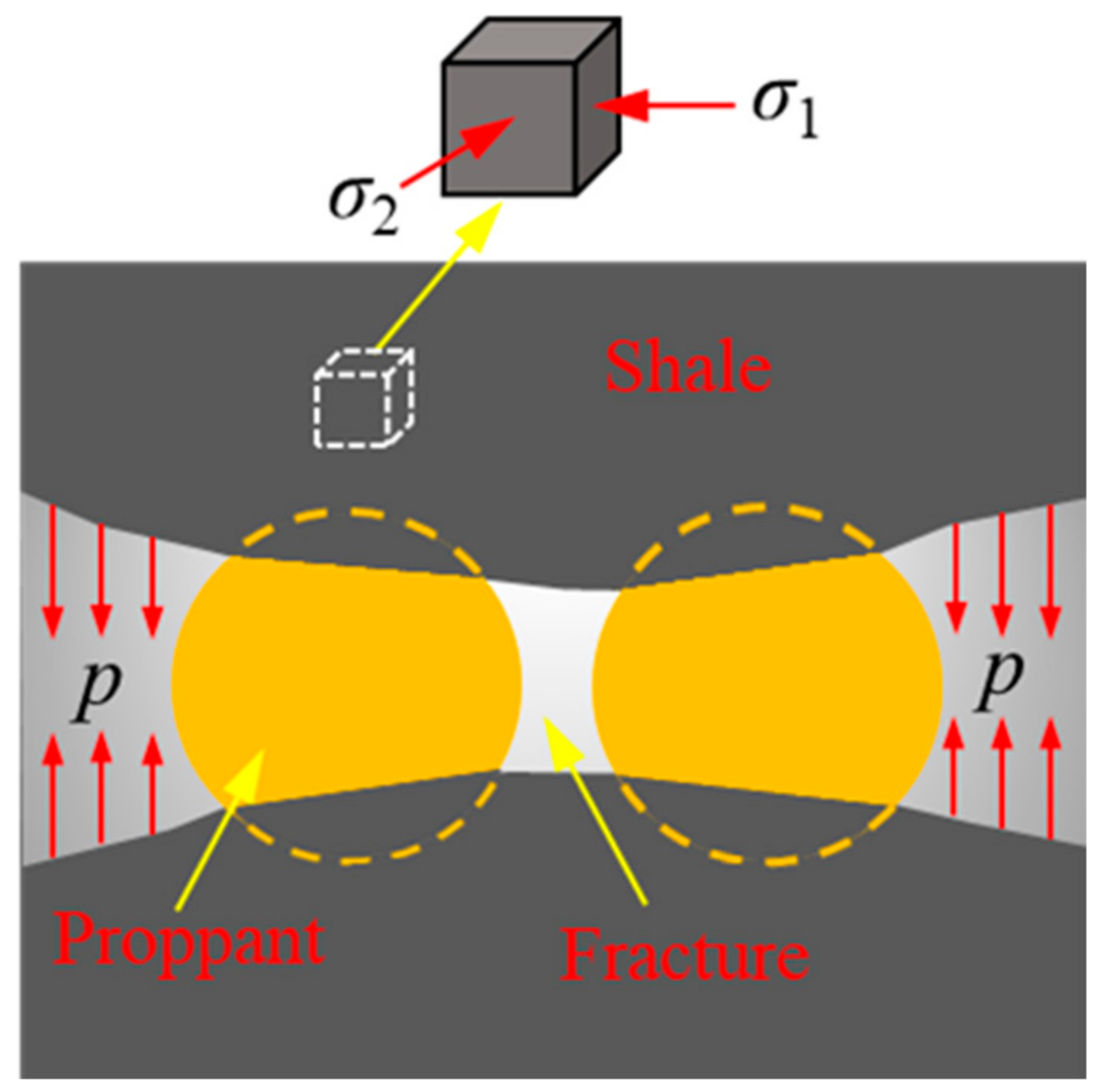

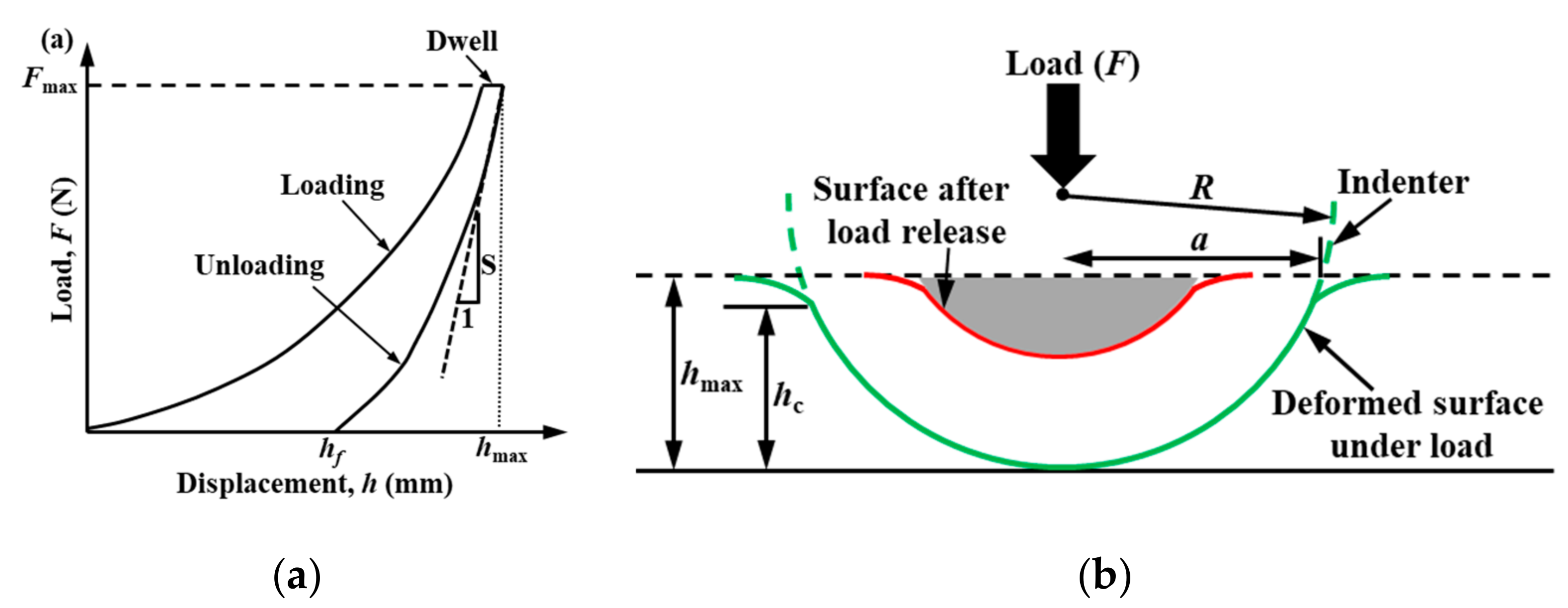


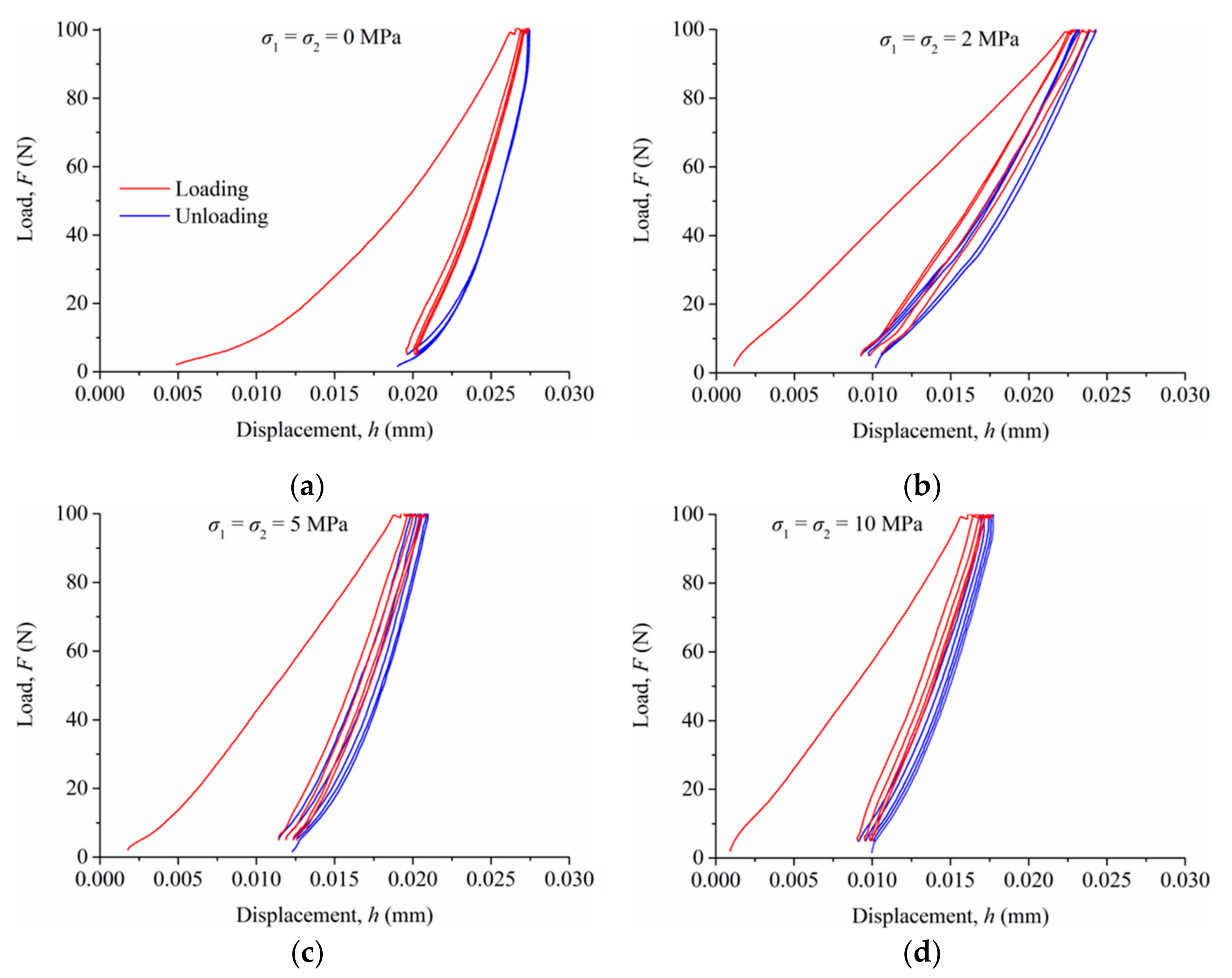
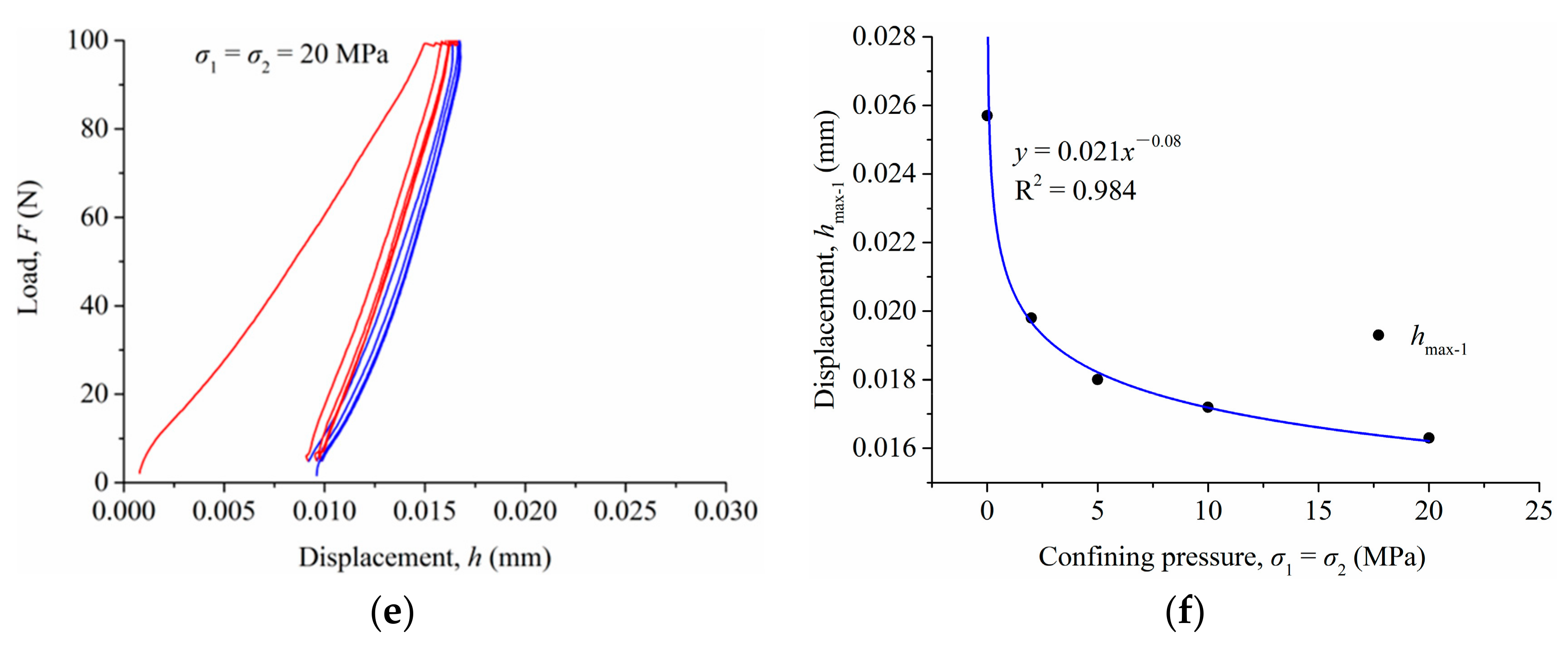
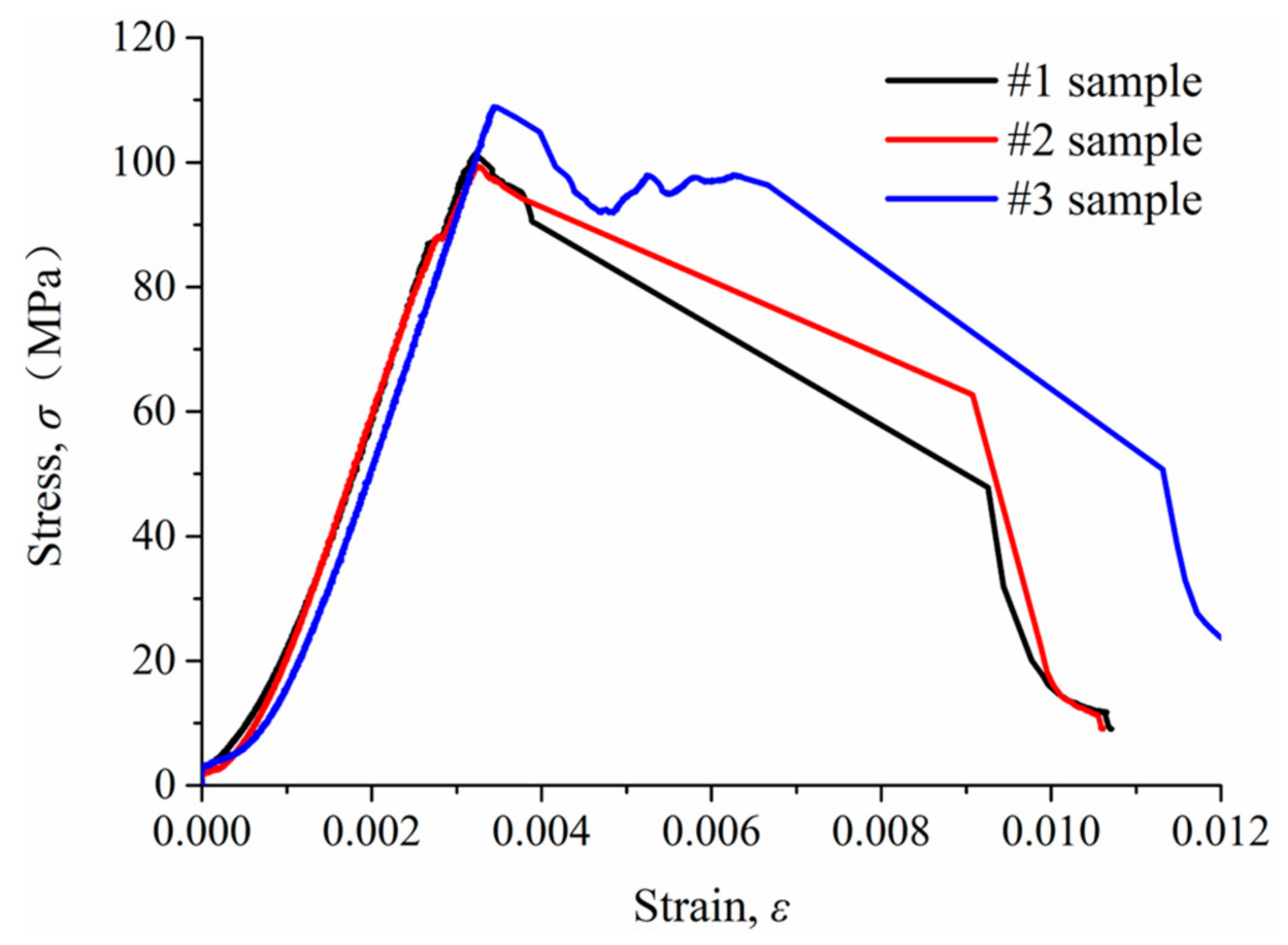
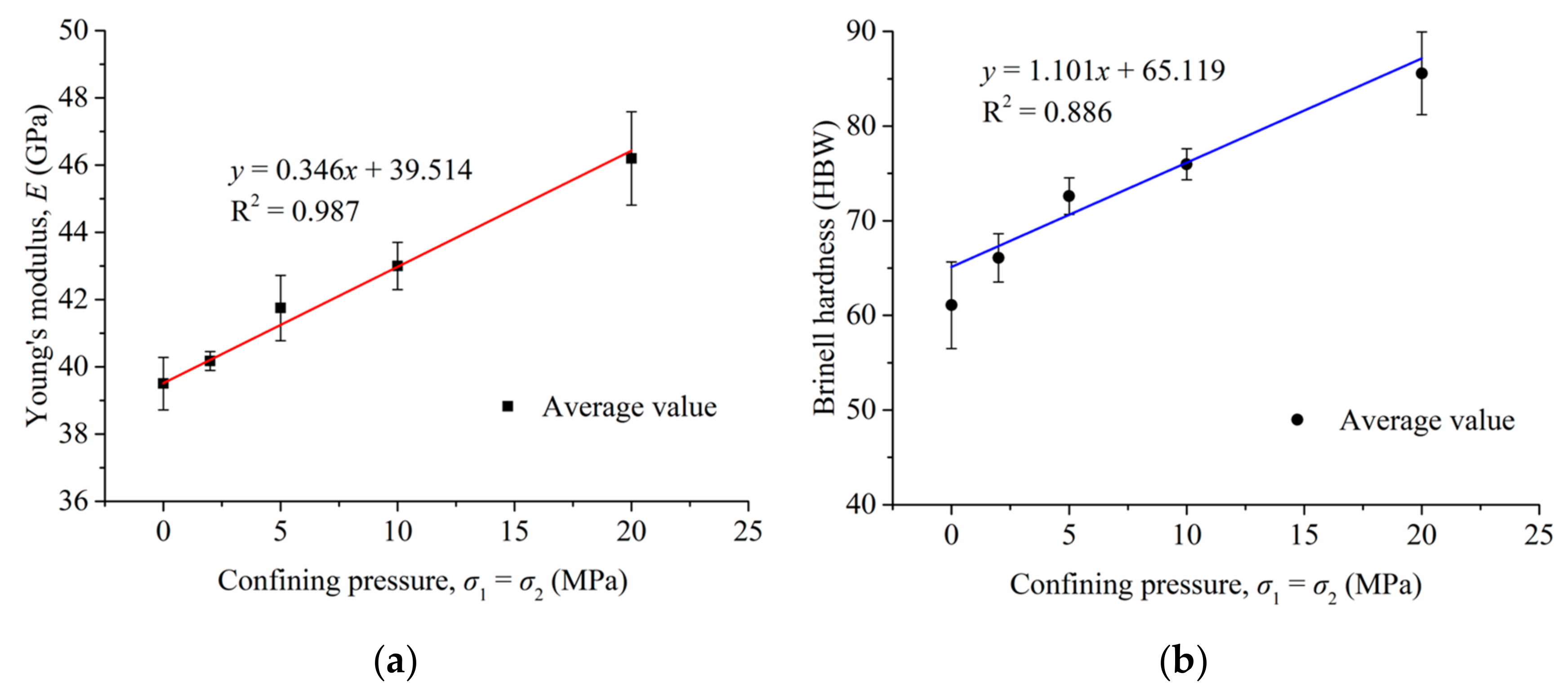
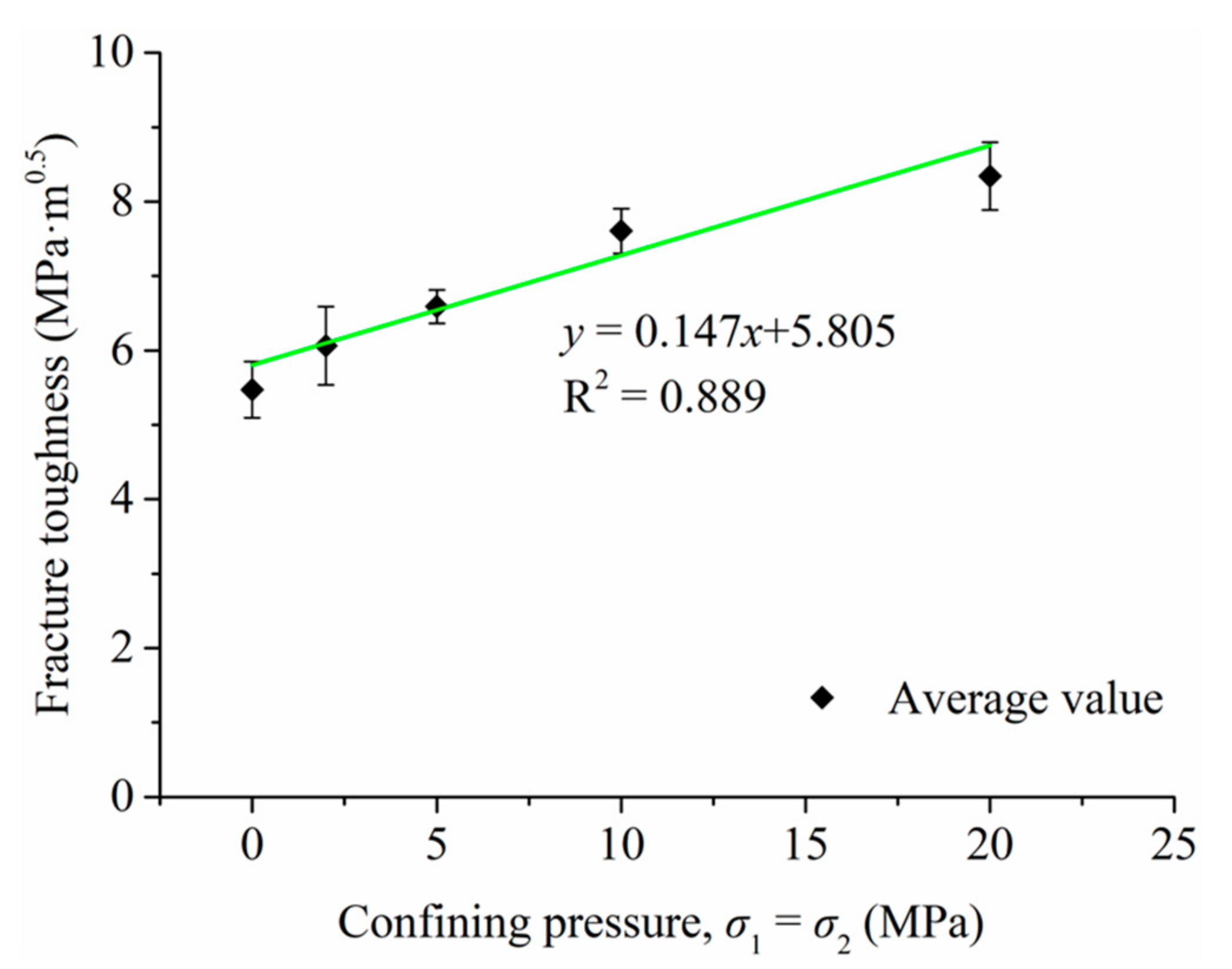
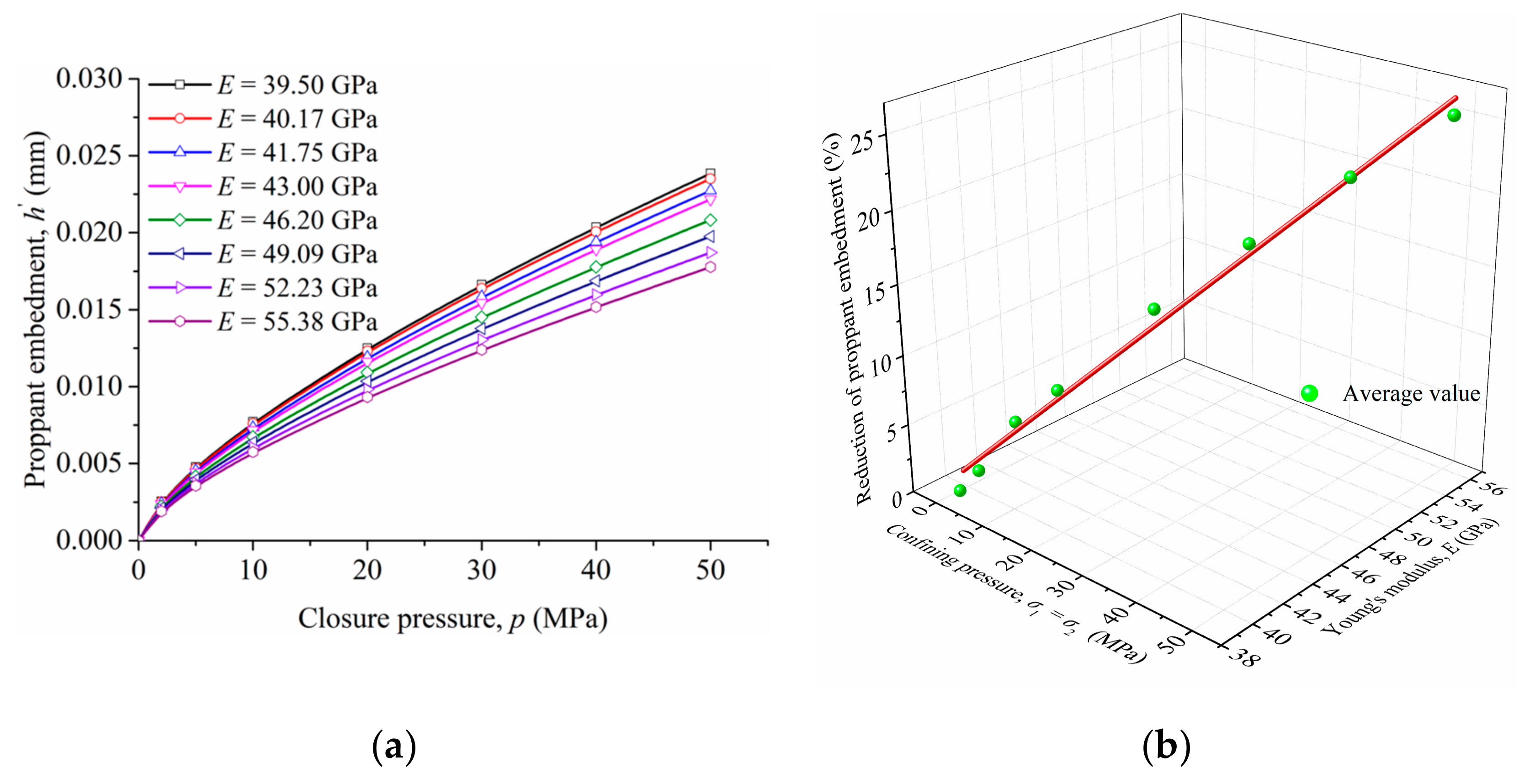

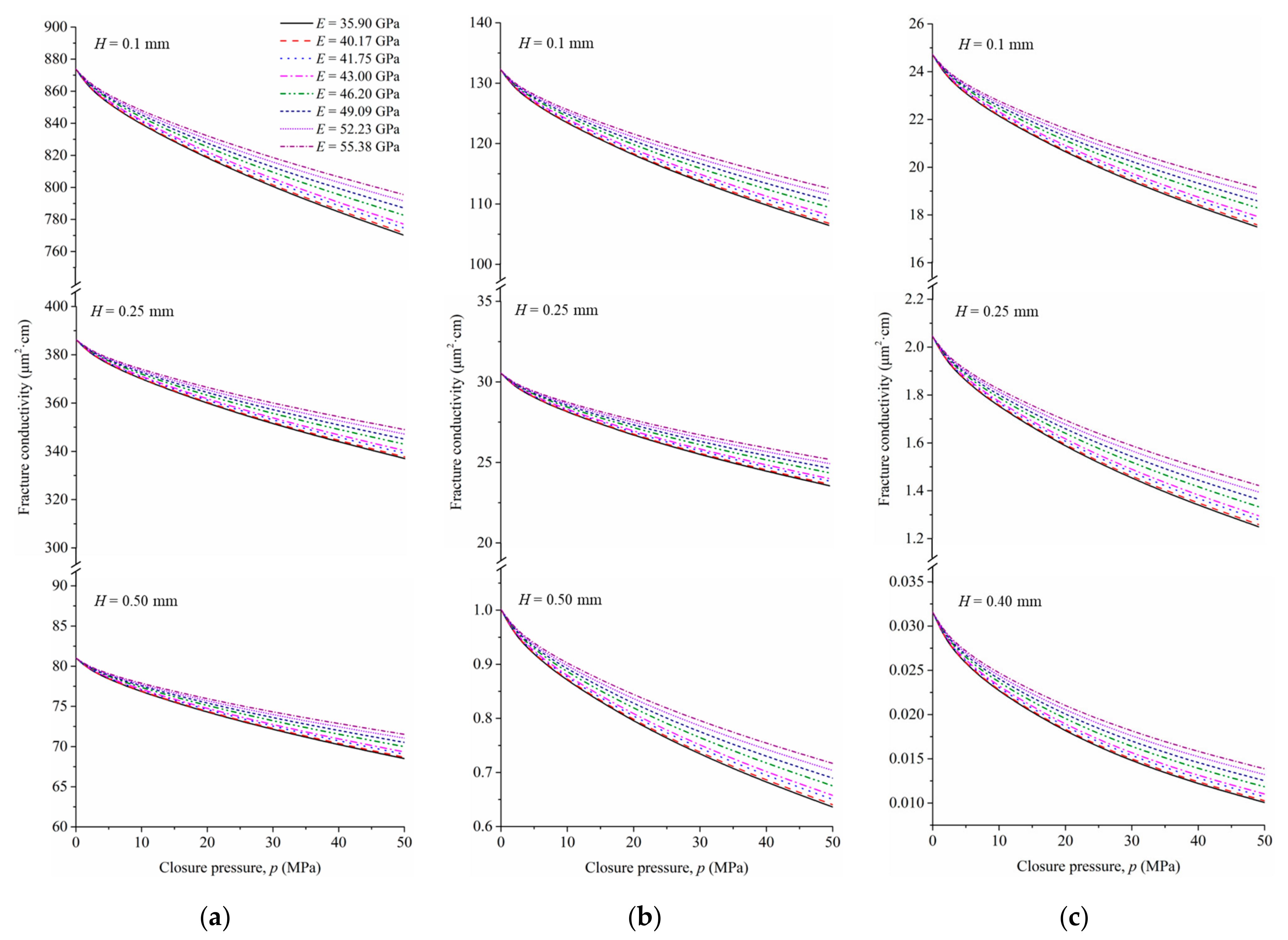
| Samples | Mineral (wt%) | |||||||
|---|---|---|---|---|---|---|---|---|
| Quartz | Orthoclase | Albite | Calcite | Dolomite | Pyrite | Chlorite | Illite | |
| Shale | 12.9 | 0.2 | 2.4 | 15.5 | 55.5 | 0.4 | 2.6 | 10.6 |
| Shale Samples | UCS (MPa) | E (GPa) | ν |
|---|---|---|---|
| 1# sample | 101.38 | 40.03 | 0.25 |
| 2# sample | 99.38 | 39.98 | 0.25 |
| 3# sample | 104.60 | 40.10 | 0.25 |
| Average values | 101.79 | 40.04 | 0.25 |
Disclaimer/Publisher’s Note: The statements, opinions and data contained in all publications are solely those of the individual author(s) and contributor(s) and not of MDPI and/or the editor(s). MDPI and/or the editor(s) disclaim responsibility for any injury to people or property resulting from any ideas, methods, instructions or products referred to in the content. |
© 2024 by the authors. Licensee MDPI, Basel, Switzerland. This article is an open access article distributed under the terms and conditions of the Creative Commons Attribution (CC BY) license (https://creativecommons.org/licenses/by/4.0/).
Share and Cite
Song, J.; Liu, Y.; Luo, Y.; Yang, F.; Hu, D. Effect of Lateral Confining Pressure on Shale’s Mechanical Properties and Its Implications for Fracture Conductivity. Appl. Sci. 2024, 14, 5825. https://doi.org/10.3390/app14135825
Song J, Liu Y, Luo Y, Yang F, Hu D. Effect of Lateral Confining Pressure on Shale’s Mechanical Properties and Its Implications for Fracture Conductivity. Applied Sciences. 2024; 14(13):5825. https://doi.org/10.3390/app14135825
Chicago/Turabian StyleSong, Jinliang, Yuan Liu, Yujie Luo, Fujian Yang, and Dawei Hu. 2024. "Effect of Lateral Confining Pressure on Shale’s Mechanical Properties and Its Implications for Fracture Conductivity" Applied Sciences 14, no. 13: 5825. https://doi.org/10.3390/app14135825






